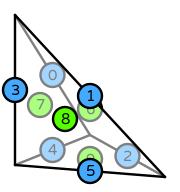an encyclopedia of finite element definitions
Degree 2 Morley–Wang–Xu on a tetrahedron
◀ Back to Morley–Wang–Xu definition page
- \(R\) is the reference tetrahedron. The following numbering of the subentities of the reference cell is used:
- \(\mathcal{V}\) is spanned by: \(1\), \(x\), \(x^{2}\), \(y\), \(x y\), \(y^{2}\), \(z\), \(x z\), \(y z\), \(z^{2}\)
- \(\mathcal{L}=\{l_0,...,l_{9}\}\)
- Functionals and basis functions:

\(\displaystyle l_{0}:\mathbf{v}\mapsto\displaystyle\int_{e_{0}}(\tfrac{\sqrt{2}}{2})v\)
where \(e_{0}\) is the 0th edge.
\(\displaystyle \phi_{0} = - 2 x^{2} - 4 x y - 4 x z + \frac{8 x}{3} + y^{2} + 2 y z + \frac{2 y}{3} + z^{2} + \frac{2 z}{3} - \frac{2}{3}\)
This DOF is associated with edge 0 of the reference cell.
where \(e_{0}\) is the 0th edge.
\(\displaystyle \phi_{0} = - 2 x^{2} - 4 x y - 4 x z + \frac{8 x}{3} + y^{2} + 2 y z + \frac{2 y}{3} + z^{2} + \frac{2 z}{3} - \frac{2}{3}\)
This DOF is associated with edge 0 of the reference cell.
\(\displaystyle l_{1}:\mathbf{v}\mapsto\displaystyle\int_{e_{1}}(\tfrac{\sqrt{2}}{2})v\)
where \(e_{1}\) is the 1st edge.
\(\displaystyle \phi_{1} = x^{2} - 4 x y + 2 x z + \frac{2 x}{3} - 2 y^{2} - 4 y z + \frac{8 y}{3} + z^{2} + \frac{2 z}{3} - \frac{2}{3}\)
This DOF is associated with edge 1 of the reference cell.
where \(e_{1}\) is the 1st edge.
\(\displaystyle \phi_{1} = x^{2} - 4 x y + 2 x z + \frac{2 x}{3} - 2 y^{2} - 4 y z + \frac{8 y}{3} + z^{2} + \frac{2 z}{3} - \frac{2}{3}\)
This DOF is associated with edge 1 of the reference cell.
\(\displaystyle l_{2}:\mathbf{v}\mapsto\displaystyle\int_{e_{2}}(\tfrac{\sqrt{2}}{2})v\)
where \(e_{2}\) is the 2nd edge.
\(\displaystyle \phi_{2} = x^{2} + 2 x y - 4 x z + \frac{2 x}{3} + y^{2} - 4 y z + \frac{2 y}{3} - 2 z^{2} + \frac{8 z}{3} - \frac{2}{3}\)
This DOF is associated with edge 2 of the reference cell.
where \(e_{2}\) is the 2nd edge.
\(\displaystyle \phi_{2} = x^{2} + 2 x y - 4 x z + \frac{2 x}{3} + y^{2} - 4 y z + \frac{2 y}{3} - 2 z^{2} + \frac{8 z}{3} - \frac{2}{3}\)
This DOF is associated with edge 2 of the reference cell.
\(\displaystyle l_{3}:\mathbf{v}\mapsto\displaystyle\int_{e_{3}}v\)
where \(e_{3}\) is the 3rd edge.
\(\displaystyle \phi_{3} = 6 x y - 2 x - 2 y + 1\)
This DOF is associated with edge 3 of the reference cell.
where \(e_{3}\) is the 3rd edge.
\(\displaystyle \phi_{3} = 6 x y - 2 x - 2 y + 1\)
This DOF is associated with edge 3 of the reference cell.
\(\displaystyle l_{4}:\mathbf{v}\mapsto\displaystyle\int_{e_{4}}v\)
where \(e_{4}\) is the 4th edge.
\(\displaystyle \phi_{4} = 6 x z - 2 x - 2 z + 1\)
This DOF is associated with edge 4 of the reference cell.
where \(e_{4}\) is the 4th edge.
\(\displaystyle \phi_{4} = 6 x z - 2 x - 2 z + 1\)
This DOF is associated with edge 4 of the reference cell.
\(\displaystyle l_{5}:\mathbf{v}\mapsto\displaystyle\int_{e_{5}}v\)
where \(e_{5}\) is the 5th edge.
\(\displaystyle \phi_{5} = 6 y z - 2 y - 2 z + 1\)
This DOF is associated with edge 5 of the reference cell.
where \(e_{5}\) is the 5th edge.
\(\displaystyle \phi_{5} = 6 y z - 2 y - 2 z + 1\)
This DOF is associated with edge 5 of the reference cell.
\(\displaystyle l_{6}:\mathbf{V}\mapsto\displaystyle \frac{\sqrt{3}}{3}\int_{f_{0}}\frac{\partial}{\partial\left(\begin{array}{c}\displaystyle \frac{\sqrt{3}}{3}\\\displaystyle \frac{\sqrt{3}}{3}\\\displaystyle \frac{\sqrt{3}}{3}\end{array}\right)}v\)
where \(f_{0}\) is the 0th face.
\(\displaystyle \phi_{6} = \frac{\sqrt{3} \left(3 x^{2} + 6 x y + 6 x z - 4 x + 3 y^{2} + 6 y z - 4 y + 3 z^{2} - 4 z + 1\right)}{3}\)
This DOF is associated with face 0 of the reference cell.
where \(f_{0}\) is the 0th face.
\(\displaystyle \phi_{6} = \frac{\sqrt{3} \left(3 x^{2} + 6 x y + 6 x z - 4 x + 3 y^{2} + 6 y z - 4 y + 3 z^{2} - 4 z + 1\right)}{3}\)
This DOF is associated with face 0 of the reference cell.
\(\displaystyle l_{7}:\mathbf{V}\mapsto\displaystyle \int_{f_{1}}\frac{\partial}{\partial\left(\begin{array}{c}\displaystyle 1\\\displaystyle 0\\\displaystyle 0\end{array}\right)}v\)
where \(f_{1}\) is the 1st face.
\(\displaystyle \phi_{7} = x \left(2 - 3 x\right)\)
This DOF is associated with face 1 of the reference cell.
where \(f_{1}\) is the 1st face.
\(\displaystyle \phi_{7} = x \left(2 - 3 x\right)\)
This DOF is associated with face 1 of the reference cell.
\(\displaystyle l_{8}:\mathbf{V}\mapsto\displaystyle \int_{f_{2}}\frac{\partial}{\partial\left(\begin{array}{c}\displaystyle 0\\\displaystyle -1\\\displaystyle 0\end{array}\right)}v\)
where \(f_{2}\) is the 2nd face.
\(\displaystyle \phi_{8} = y \left(3 y - 2\right)\)
This DOF is associated with face 2 of the reference cell.
where \(f_{2}\) is the 2nd face.
\(\displaystyle \phi_{8} = y \left(3 y - 2\right)\)
This DOF is associated with face 2 of the reference cell.
\(\displaystyle l_{9}:\mathbf{V}\mapsto\displaystyle \int_{f_{3}}\frac{\partial}{\partial\left(\begin{array}{c}\displaystyle 0\\\displaystyle 0\\\displaystyle 1\end{array}\right)}v\)
where \(f_{3}\) is the 3rd face.
\(\displaystyle \phi_{9} = z \left(2 - 3 z\right)\)
This DOF is associated with face 3 of the reference cell.
where \(f_{3}\) is the 3rd face.
\(\displaystyle \phi_{9} = z \left(2 - 3 z\right)\)
This DOF is associated with face 3 of the reference cell.